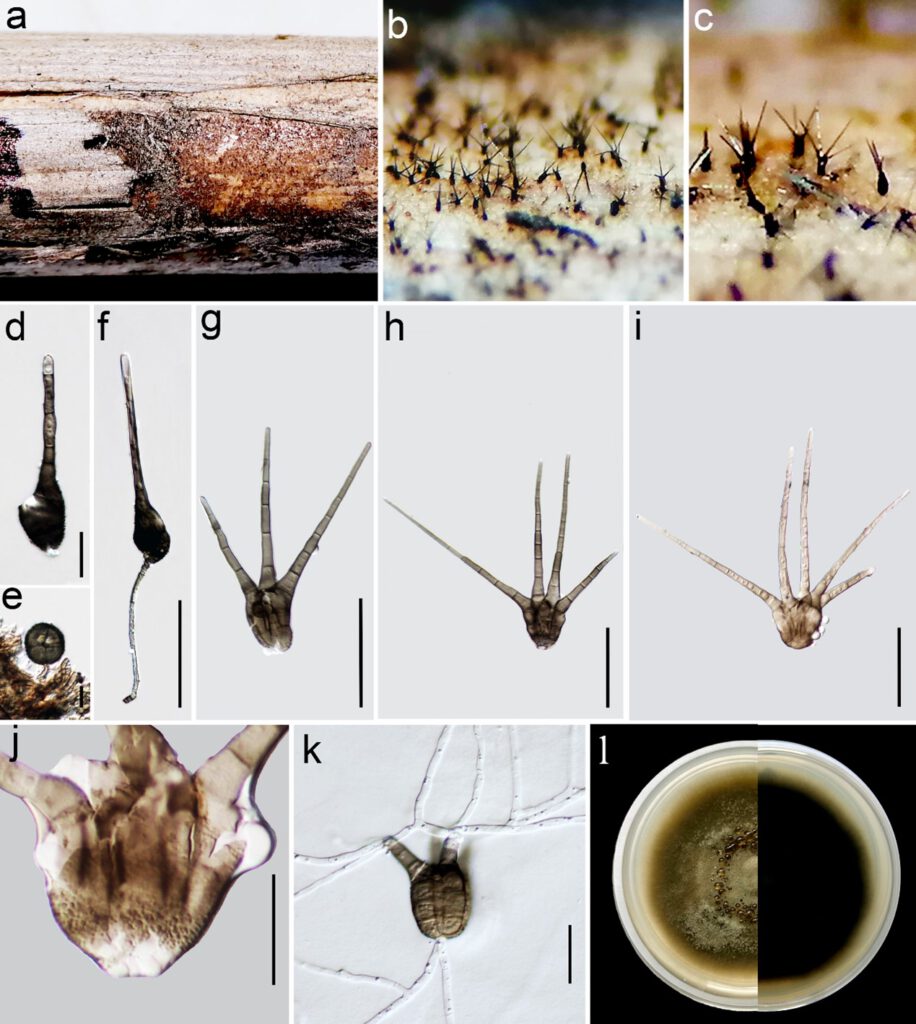Tetraploa obpyriformis C.F. Liao & Doilom sp. nov.
MycoBank number: MB 559272; Index Fungorum number: IF 559272; Facesoffungi number: FoF 10586;
Etymology: Referring to the obpyriform conidia character of this fungi.
Holotype: KUMCC 21-0011
Saprobic on dead stem of Saccharum arundinaceum, Sexual morph undetermined. Asexual morph conidiophores absent. Conidigenous cells monotretic, integrated, intercalary, clavate, no septate, rough well, short or longer, usually undistinguishable with struct of conidiophores. Conidia 31–47 × 17–39 µm ( = 36 × 26 µm, n = 30), obpyriform or cylindrical, dark green to light brown, smoothly with minutely verruculose at base, composed with four columns, each columns have 2-4 septate, almost have three septate, mostly have four apical appendages, rarely have one, two or five. Appendages 50 – 161 µm ( = 98 µm, n = 30) long, 6 – 10 µm wide at the base, 2 – 4 µm wide at the apex, smoothly, unbranched, brown to dark brown, almost hyaline at apical,4–12 septate, straight or slightly.
Culture characteristics: Colonies on PDA at 25±2 ℃, after 17 days reaching to 40-45 mm, floccose, convex or dome-shaped, mucoid or oil droplets at the center, light gray to dark green and almost glabrous towards the periphery, with a fimbriate margin; reverse blackish green to light brown; no pigment production.
Material examined: China, Yunnan Province, Kunming City, from dead grass under Saccharum arundinaceum (Gramineae), 4 July 2020, C.F. Liao, (KUN–HKAS 107637, holotype), ex-type culture KUMCC 21-0011.
Genbank number: ITS: ######, LSU: ######, SSU: ######, BT: #####, TEF1-α: #####
Notes: In phylogenetic analysis, our new collection of Tetraploa obpyriformis (KUMCC 21-0011) with strain of Tetraploa endophytica (CBS 147114) with high bootstrap support (ML: 89, BYPP: 0.99). However, KUMCC 21-0011 can be well separated from Tetraploa endophytica (CBS 147114) (Fig ##). Tetraploa endophytica (CBS 147114) was introduced to an endophytic fungus by Crous (2021) and photo was unavailabl. In morphology, KUMCC 21-0011 was similar to type strain of genus Tetraploa (KT 563) by its asexual morph have monoblastic conidiogenous cells, conidia cylindrical comprising of several columns, verrucose at base with serval appendage at apical. In addition, Tetraploa obpyriformis differs from Tetraploa sasicola (KT 563) in having shorter (98 µm vs 142.9 µm) and more counts of appendage (number 5 vs number 4). Hence, we introduced Tetraploa obpyriformis (KUMCC 21-0011) to a new species based available sequence and phylogenetic tree.

Figure. ### Tetraploa ##### (KUN–HKAS 107637, holotype). a–c. Conidia on host substrate; d–i. Conidia; j. Verrucose conidia; k. Germinating conidium; l. Colony on PDA (left-front, right-reverse); Scale bars: d, j, k = 20 μm, d = 10 μm, f-i = 50 μm.
